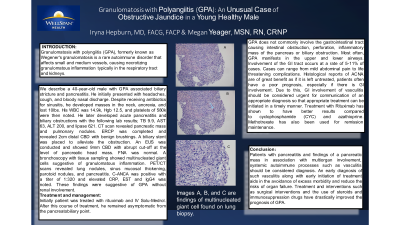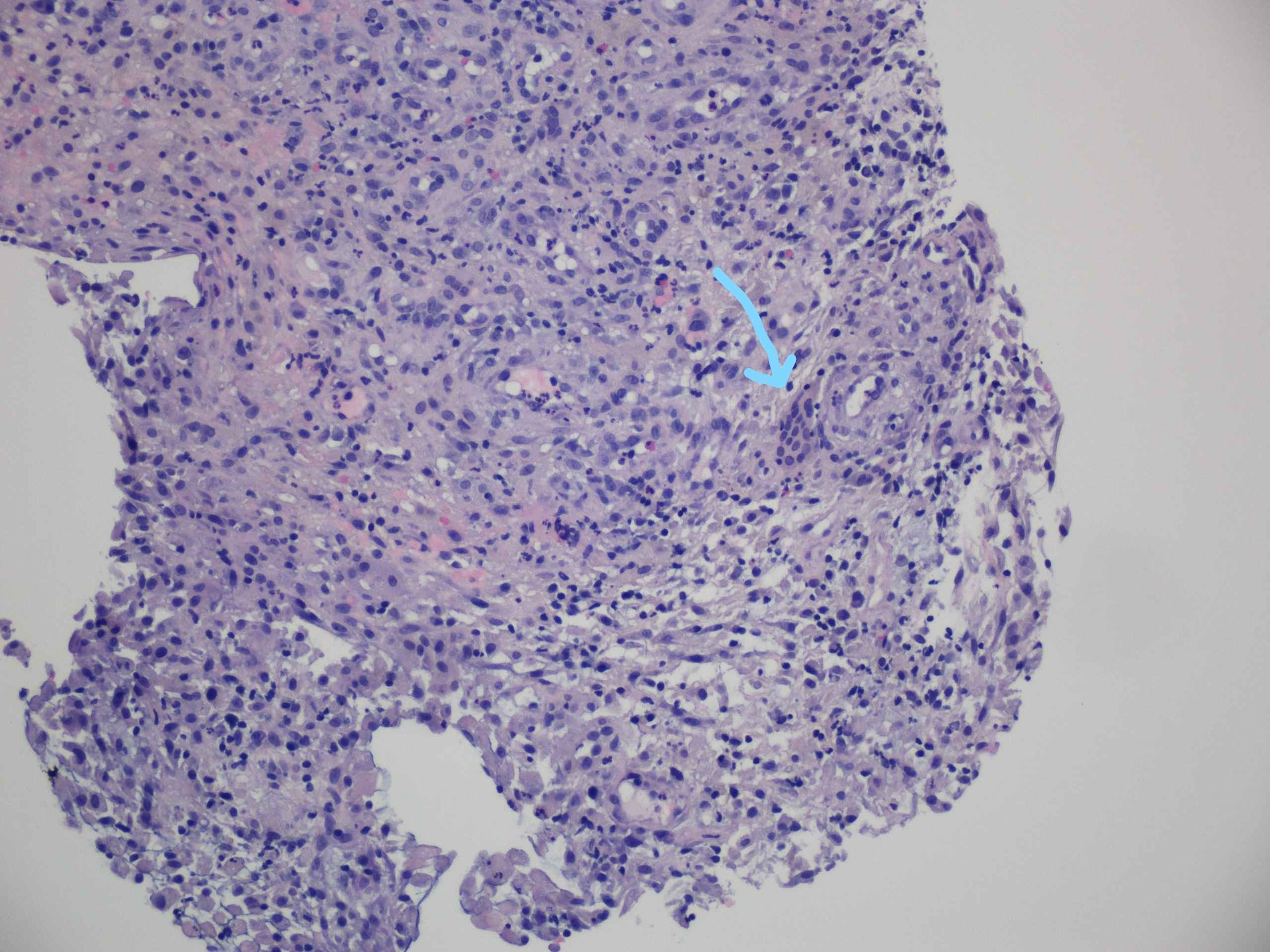Sunday Poster Session
Category: Biliary/Pancreas
P0122 - Granulomatosis With Polyangiitis: Unusual Cause of Obstructive Jaundice in a Young Healthy Male
Sunday, October 22, 2023
3:30 PM - 7:00 PM PT
Location: Exhibit Hall

Has Audio
- IH
Iryna Hepburn, MD, FACG
WellSpan
Lebanon, Pennsylvania
Presenting Author(s)
Megan Yeager, MSN, RN, CRNP1, Mariah McCready, MD2, Iryna Hepburn, MD, FACG1
1WellSpan, Lebanon, PA; 2UPMC, Lititz, PA
Introduction: GPA is one of the ANCA associated vasculitidies that affects small vessels causing necrotizing granulomatous inflammation in respiratory tract and kidneys. Rarely it affects GI tract causing pancreatic mass and biliary obstruction.
Case Description/Methods: We describe a 40yo male with GPA associated biliary stricture and pancreatitis. Patient presented with headaches, cough, and bloody nasal discharge. Despite antibiotics he developed masses in his neck, anorexia, and lost 10 lbs. WBC14.9k, Hg12.5, and platelets 580k were noted. Later he developed acute pancreatitis and biliary obstruction (TB9.9, AST63, ALT200, and lipase621). CT showed pancreatic mass and pulmonary nodules. ERCP revealed 2cm distal CBD, but brushings were benign. Biliary stent was placed to alleviate obstruction. EUS showed 9mm CBD with abrupt cut-off at the level of pancreatic head mass,2.5x1.8cm. FNA was normal. Bronchoscopy tissue sampling showed multinucleated giant cells suggestive of granulomatous inflammation. PET/CT revealed lung nodules, sinus mucosal thickening, parotid nodules, and pancreatitis. cANCA was positive,1:320. Elevated CRP, ESR, IgG4 were seen. Based on these findings patient was diagnosed with GPA without renal involvement. After treatment with rituximab and Solu-Medrol IV his shortness of breath and sinusitis resolved, appetite improved, and he gained weight. cANCA titer decreased to 1:20. He remained asymptomatic from the pancreatobiliary point.
Discussion: GPA is the most common of ANCA associated vasculitides with incidence of 10-20 per 1 million. It usually presents with respiratory symptoms (90%, sinusitis, crusting, epistaxis, lung nodules), systemic vasculitis, and renal involvement (10-20% of patients on initial presentation). GI involvement is rare, 5-11% of cases (abdominal pain, hemorrhage, intestinal obstruction, perforation, pancreatitis, and cholecystitis). It is associated with severe illness, rapid progression and risk of multiorgan failure. It requires high doses of steroids and significant immunosuppression with rituximab or cyclophosphamide to achieve remission. In conclusion, in patients with pancreatitis and pancreatic mass in association with multiorgan involvement, systemic autoimmune process such as vasculitis must be considered. Recent new therapies, including surgical intervention, use of steroids and immunosuppression, have improved prognosis of GPA drastically. Early diagnosis and treatment would help avoid excess morbidity and potentially reduce risk of organ failure.

Disclosures:
Megan Yeager, MSN, RN, CRNP1, Mariah McCready, MD2, Iryna Hepburn, MD, FACG1. P0122 - Granulomatosis With Polyangiitis: Unusual Cause of Obstructive Jaundice in a Young Healthy Male, ACG 2023 Annual Scientific Meeting Abstracts. Vancouver, BC, Canada: American College of Gastroenterology.
1WellSpan, Lebanon, PA; 2UPMC, Lititz, PA
Introduction: GPA is one of the ANCA associated vasculitidies that affects small vessels causing necrotizing granulomatous inflammation in respiratory tract and kidneys. Rarely it affects GI tract causing pancreatic mass and biliary obstruction.
Case Description/Methods: We describe a 40yo male with GPA associated biliary stricture and pancreatitis. Patient presented with headaches, cough, and bloody nasal discharge. Despite antibiotics he developed masses in his neck, anorexia, and lost 10 lbs. WBC14.9k, Hg12.5, and platelets 580k were noted. Later he developed acute pancreatitis and biliary obstruction (TB9.9, AST63, ALT200, and lipase621). CT showed pancreatic mass and pulmonary nodules. ERCP revealed 2cm distal CBD, but brushings were benign. Biliary stent was placed to alleviate obstruction. EUS showed 9mm CBD with abrupt cut-off at the level of pancreatic head mass,2.5x1.8cm. FNA was normal. Bronchoscopy tissue sampling showed multinucleated giant cells suggestive of granulomatous inflammation. PET/CT revealed lung nodules, sinus mucosal thickening, parotid nodules, and pancreatitis. cANCA was positive,1:320. Elevated CRP, ESR, IgG4 were seen. Based on these findings patient was diagnosed with GPA without renal involvement. After treatment with rituximab and Solu-Medrol IV his shortness of breath and sinusitis resolved, appetite improved, and he gained weight. cANCA titer decreased to 1:20. He remained asymptomatic from the pancreatobiliary point.
Discussion: GPA is the most common of ANCA associated vasculitides with incidence of 10-20 per 1 million. It usually presents with respiratory symptoms (90%, sinusitis, crusting, epistaxis, lung nodules), systemic vasculitis, and renal involvement (10-20% of patients on initial presentation). GI involvement is rare, 5-11% of cases (abdominal pain, hemorrhage, intestinal obstruction, perforation, pancreatitis, and cholecystitis). It is associated with severe illness, rapid progression and risk of multiorgan failure. It requires high doses of steroids and significant immunosuppression with rituximab or cyclophosphamide to achieve remission. In conclusion, in patients with pancreatitis and pancreatic mass in association with multiorgan involvement, systemic autoimmune process such as vasculitis must be considered. Recent new therapies, including surgical intervention, use of steroids and immunosuppression, have improved prognosis of GPA drastically. Early diagnosis and treatment would help avoid excess morbidity and potentially reduce risk of organ failure.

Figure: Marked on the image is the giant cell noted on lung biopsy
Disclosures:
Megan Yeager indicated no relevant financial relationships.
Mariah McCready indicated no relevant financial relationships.
Iryna Hepburn indicated no relevant financial relationships.
Megan Yeager, MSN, RN, CRNP1, Mariah McCready, MD2, Iryna Hepburn, MD, FACG1. P0122 - Granulomatosis With Polyangiitis: Unusual Cause of Obstructive Jaundice in a Young Healthy Male, ACG 2023 Annual Scientific Meeting Abstracts. Vancouver, BC, Canada: American College of Gastroenterology.
